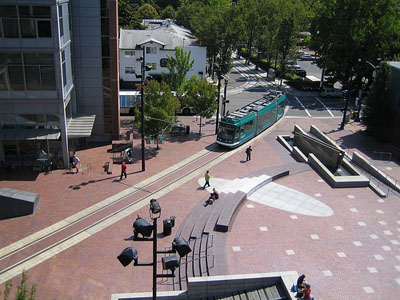Chicago was once home to the world’s largest streetcar network.
Today, streetcars are making a
comeback. Their nostalgic nature and picturesque characteristics are embraced by
small business corridors and can provide better accessibility for underserved
transit areas. Portland’s successful streetcars
travel along an 8-mile looped route (4-miles each way) that provides services
for college students at Portland State University, shoppers and residents in the
Pearl District, tourists to downtown attractions, and visitors along the
waterfront. When the streetcar was brought back to life in Portland, officials
projected 3,500 riders a day. Ridership is growing 17 percent every year and
serves more than 10,000 riders a day. The success of Portland’s $55.2 million
streetcar network has generated about $2.5 billion in new construction within
three blocks of the line since the plan was first announced in 1997.

Portland's Streetcar - Photo
Courtesy of Crandall Arambula
Streetcars are designed primarily
for distances about 5 miles long, run on a local circulation with frequent
stops, travel 12 mph or less, and are more effective in smaller corridors. While
Chicago’s
network was extensive and expanded throughout the entire city, passengers
frequently made several connections to get to where they needed to go.
Despite the confusing network in Chicago, fixed rails on the street helped
riders better understand the travel route of the streetcar and better predict
their connections.
Streetcars can add an important
element to a city’s transportation network of rail and bus services. While
outdoor cafes and walkable streets in small business corridors or suburban
downtowns don’t always go hand in hand with heavy traffic and large diesel
buses, streetcars actually encourage pedestrian friendly on-street
development. Streetcars can also provide a community with the
accessibility that it needs at a low cost with high return. Whether streetcars
are used as a connector to rapid transit lines in underserved areas or as
shuttles to the proposed Olympic venues, the streetcar is another tool in the
toolbox to help provide better transit options for the Chicago region.
This article was featured in Talking
Transit, MPC’s bi-weekly e-newsletter. To receive the newsletter, email talkingtransit@metroplanning.org
with ‘Subscribe’ in the subject line.